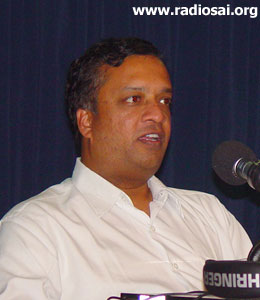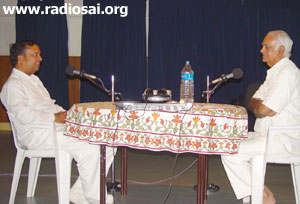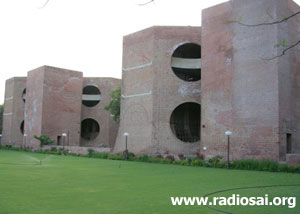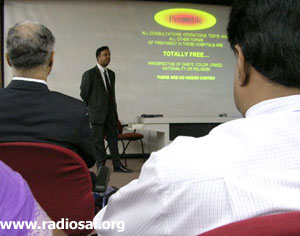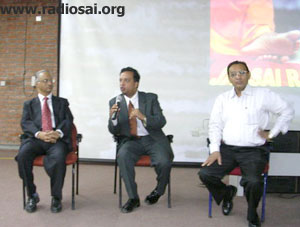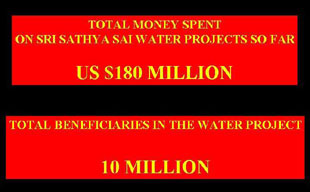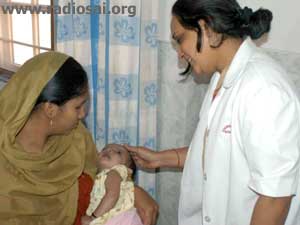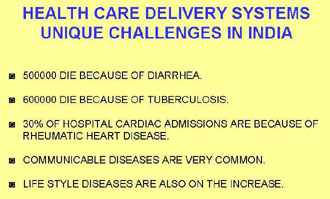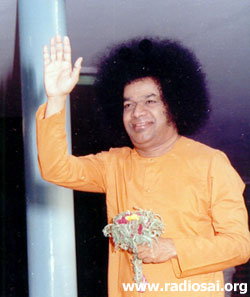 |
 |
 |
 |
| Volume 4 - Issue 06 JUNE 2006 |
|
SAI HOSPITALS - A REVELATION AT The Indian Institute of Management, Ahmedabad, (IIM-A) one of the premier business schools of India, held its first ever comprehensive health care consultation covering a wide range of issues concerning health care in India between 20th and 24th March 2006. The objective of the exercise was to increase the interaction between academics, practitioners, administrators and members of industries associated and involved with health care.
The current Indian health care scenario is at best complex. Recent trends have witnessed the persistence of age old infectious and communicable diseases with a concomitant increase in lifestyle diseases such as Diabetes Mellitus and Ischemic Heart Disease. The health care delivery mechanisms in India have not grown with time. Government hospitals have neither infrastructure nor funds to cope with the changing trends of disease while Corporate hospitals (which have had a phenomenal growth in the last decade) though having the best of technology and facilities essentially function with a business outlook. In addition to this, issues like the exodus of quality doctors from government hospitals to private healthcare sector, and of medical personnel to greener pastures outside India, low penetration of health insurance, reservations in healthcare education for specific castes, etc. have only made high quality health care increasingly inaccessible and grim for the common man.
Reflecting on the Conference, Dr. Anil says,
So much for brief summary of what went on in IIM-A. But to give a complete picture of how the presentation was received by healthcare professionals and policy makers from different disciplines and important wings of society, what questions were raised, etc. we had invited Dr. Anil to our Radio Sai studio for a chat immediately after the conference. Below are excerpts from the conversation. Prof. Venkataraman (GV) In Conversation With Dr. Anil Kumar Mulpur (AKM). GV: Sai Ram Listeners and Greetings from Prashanti Nilayam. We are very happy to have in our studios today Dr Anilkumar Mulpur, who is a cardiac surgeon in Swami’s Hospital, in Bangalore.
AKM: There were about 110 participants. The Purpose Of The IIM-A Health Conference GV: Who called for the meeting and what is the purpose? AKM: The meeting was called for the first time by Indian Institute of Management. This meeting, in their words is the unique first ever Management Consultation to get the Health Care Providers and Health Care Policy Makers together to sort out certain burning issues. GV: Why is IIM Ahmedabad interested in this? What is there in it for them, if I may ask so, as it is a business school?
AKM: These goals are related to health care in a multifactor manner. They include maternal and child health, literacy, provision of safe drinking water, rural employment, rural electrification and sanitation, and such things which will have repercussions on the health status at the community level. GV: The State is supposed to provide these things. AKM: The Indian Government has an obligation. The expectation anywhere in the world is that the Government or rulers have to provide this. Now we talk of health as a fundamental right. So people now have started to demand that this is their right and they are after the Government to demand that this right is attended to. Who Attended The Conference GV: What kind of people participated in the conference? AKM: This was a conglomeration of different people from all walks of life. We had Health Ministers, Health Secretaries, Politicians, Bureaucrats, and Government Civil Servants who are running large civil hospitals, Non Governmental Organizations, the Corporate Sector plus the industry. Industry also has a certain role to play.
AKM: Yes, Medical Camps and the related activities in terms of “Gram Seva” (Village Service Outreach Programme) and so on. Our beloved Director Dr. Safaya was invited. For personal reasons he could not go and he deputed me to go. He gave me his ideas. We all know what Sathya Sai Seva Organizations do. [To download the powerpoint presentation of Dr. Anil at IIM-A, Click here.] GV: The Hospital is not really connected to the Sathya Sai Organization. It is an institution of its own right and a world famous one too. Was the role played by the Hospital in the Indian Medical Scenario any consideration when the invitation was extended?
Why despite policy making, a good 60 years after independence, we are no way near provision of safe drinking water to State Capitals, leave alone district headquarters and villages. How should we be going about the so called private and public enterprise partnerships, to involve more of non-Governmental organizations and how exactly Government should be taking up these projects to give them a new turn, so that at least now they can come on to the right path and try to deliver health care system to all the sectors of the society?
GV: You mentioned drinking water; this was discussed in the context of ensuring health and avoiding water borne disease? AKM: That’s correct. GV: When they were talking about water, was there any opportunity for them to know about Swami’s massive drinking water projects? AKM: I have told them about the project even before they could ask me. <<laughter>> SLIDE 62 I have given them the phenomenal statistics that you have generated. So far Sathya Sai Central Trust has spent about 180 million US Dollars. Those figures were mind boggling. They couldn’t believe that in a record time we are able to cater to 10 million people, without ever approaching any Governmental Organization. SLIDE 65
AKM: Yes. The key question is how on earth is it possible to give free medical care totally, absolutely free, to anybody who walks in the hospital? This is an experiment and our hospitals have been doing this for a good decade and a half. The message has not percolated. One thing I have seen is people still have lots of misconceptions. Even when they were announcing that I will be speaking, they thought this is sort of a private hospital, managed by a trust and we are collecting funds. There are similar hospitals of that background. In the opening remarks when I said that it is 100% free they all sat upright on the chairs and listened. GV: Did they ask you about the kind of treatment?
GV: Did people appreciate the fact that most of the beneficiaries were absolutely poor people? AKM: Yes. I also tried to emphasize that we have absolutely no selection. A patient may be millionaire, and he will get the same treatment. A homeless patient may be coming and he will still get the same treatment. There is no discrimination at all; this is something unique. We don’t have any special rooms in the hospital, everybody is treated equally. GV: Did you show any pictures? I am sure you would have done it. AKM: I have not only shown the pictures of the hospitals, interiors of the hospitals, operation theatres, intensive care unit complexes. I also took the opportunity to project what we have been doing in social care and Educare in terms of our university’s recognition by the National Accreditation Assessment Council, our having achieved a double plus grade, what the Institutions look like and a few very impressive photos of the Water Projects.
GV: You seem to have been an ambassador for all the institutions of Swami. I think I should kidnap you and keep you here so that you become a spokesman for all those Institutions for and on behalf of Radio Sai. <<laughter>> What kind of other issues were discussed? You mentioned general problems like sanitation, healthcare, etc. Other Important Issues Discussed AKM: The important issues were “What is the cross-sectional status of health care delivery, especially in the corporate sector?” GV: What do you mean by that? AKM: As you speak in 2006, “How are certain hospitals which have no-profit, no-loss functioning? And what is their modus operandi?” “How are the problems faced by civil hospitals and so called Government hospitals unique and how are they being tackled, with lots of political pressures, etc. and interferences which are characteristic of our health care delivery system even at tertiary level in Government set up?” And then they discussed about Tele-medicine and what technology can do so that remote people can be accessible as far as health care is concerned. They showed certain shots where we had the Chief of ISRO coming up and speaking to us, Mr Sathya Murthy. Other things discussed were about the experiments which have been done by Non-Governmental Organizations. The next topic discussed was to look at the disease burden and projections. For example “What is the Psychiatry disease burden like? What is the Neurology burden? What is the cardiology disease burden like in the next few years?” so that they can frame policies and change existing policies such that these individual problems can be looked at. The Unique Counseling Department At SSSIHMS GV: I want to ask you a question, which I think you would appreciate, since you deal with patients, many often poor and illiterate. When an educated person comes to you as a patient, you can ask questions and he will understand what you are trying to ask and will give you fairly precise answers. When a person comes, who does not know how to describe his address, you may not be able to find out by asking questions what exactly the patient is suffering from. His descriptors are vague; he is not used to this kind of dialogue. You have of course your instruments, which will tell their own story, but in the ultimate analysis, you would I am sure, like to talk to the patients – were these kind of problems, addressed at all? I think it is one thing to treat educated patients and quite another thing to treat someone who absolutely has no idea of what modern medicine is.
GV: And this is absolutely fascinating, I didn’t know about it. Why don’t you enlighten and educate me and our listeners a little bit more about our follow up program, where you are going to use the services of Doctor devotees, to follow-up post operative or post treatment scenario of Patients who are treated in Swami’s hospital? Tell us something more. AKM: Whenever we see a patient, we have always been trained to see him as a whole in the background of his family, in the background of his occupation and never to do piece-meal work. So a tertiary care specialist will come to do only a piecemeal work, but he should not lose the sight of the overall background of the patient GV: In what way is that important? AKM: In what we call as a tertiary level of health delivery, we have something known as “Disability limitation and rehabilitation.”
You pick up certain problems which cannot be solved at village level, in the Government setup District Hospitals that provide secondary care. In the Sri Sathya Sai Seva Organizations, the equivalent will be Sri Sathya Sai General Hospital and also similar hospitals and nursing home which have been identified by our groups of workers in various parts of India.
GV: What is Tertiary Care? AKM: Tertiary Care is where you have advanced specialties like Cardiology, Cardio thoracic surgery, Neurology, Nephrology, Neuro surgery, Plastic surgery and certain advanced aspects such as Gastro Entrology and Pediatric surgery. They are all tertiary care, where second level of referral will come to them. They are very specialized in certain aspects and they cater to that and the patient is transferred back to the Primary care physicians so that they are followed up. In our situation (in India), what is happening is we have the Primary and Secondary and after that, they go to the tertiary, and when they go back, there is no proper follow-up. In our hospitals, they come to tertiary, from the length and breadth of the country.
GV: How many doctors are empanelled in the follow-up service? AKM: More than 100 doctors covering all the 27 districts of Karnataka, roughly 4 doctors per district. GV: Now the doctors are there, how do the patients know where they have to go to see the Doctors? AKM: When we discharge, we tell them who the nearest contact person is. We also tell them where a good quality laboratory is. Again there is no uniform standard in labs. And certain of the life saving medicines, such as Warfarin, we need to alter, which is an anti coagulant, in the light of their investigations. If he goes to a lab where the investigations are done and I cannot depend on the quality of the investigations, we are doing more harm than good. So we try to identify good quality labs, good quality doctors and direct the patients to them, so that we can take sensible decisions. GV: When was this programme started? AKM: This is a good one and a half years ago. GV: What are the results so far? What are the trends that you can see? First of all, is this working out well? Do patients go? GV: And later, what is the method through which the Doctors communicate to you? AKM: Manual, for the time being also by electronic media. Electronic Media is not present everywhere, but we try to encourage them to use electronic media (internet), as it is quite fast and they can answer them. We also hopefully will install a hot line and any patient can ring that number 24x7 and have some clarifications. That would mean you will have a million calls a day. <<Laughter>> Initially you will have some physicians who will screen them 24x7 and if that physician cannot answer, they will have access to the Hotline, so that the patient will have access to a Primary caring Doctor 24x7 in a tertiary set up. Preventive Care And Health Education
AKM: Rheumatic Heart Disease starts off with streptococcal infection of the throat. And if this particular infection of the throat is diagnosed properly and treated with adequate antibiotics like penicillin in the community and general community health status and environment is improved, in terms of housing and prevention of overcrowding we will never have this magnitude of problem. GV: When you are taking about Healthcare for all, we are not able to provide even access to something like buying a tablet, what do you do? AKM: On paper, all these areas which you have mentioned Government will say, “They also fall under such and such sub-center, which belongs to a Primary Health center.” It is open secret that we don’t have adequate doctors in rural background or paramedical personnel and therefore someone who probably has half knowledge gives out dangerous medicines. The villagers are totally away from civilization. On one hand you have got such advancement in Information Technology. On the other hand we have 70% of rural India where only 25% of doctors are practicing. This issue needs to be addressed by Government. GV: Apart from this you talked about education. You can use the medium of Television, which is commercialized, even in the Government sector. So who is going to talk about Primary Health Care and matters relating to being clean, taking precautions, taking Vitamin A to avoid problems to the eye at an early age – how are we to do this?
AKM: We know that Government is unable to do this; there is no doubt about it - because of sheer population, numbers, etc. So what I feel is the so called non-Governmental and voluntary organizations have to do a large part. The projects of the Sri Sathya Sai Seva Organizations are a role model. We have started this; we have shown how it can be done. My take home message in the Indian Institute of Management was “Comprehensive health care can be provided at primary, secondary and tertiary level, absolutely free of cost with a good quality.” SLIDE 48 And I said, “We are not here to wipe the disease burden from the face of the humanity. People should look at us and take our role model and grow in greater numbers and replicate this.” Go to villages and speak to them about health education, sanitation and safe drinking water. Actively take part, involve the community, adopt villages, even industry should to this.
The goal is there is a preventive approach. And some of these cardiac problems also can be covered. Now that you have started this follow-up do you think it is worthwhile to initiate by bringing together these two great institutions created by Swami, the Hospital and the Organization to spread health care education? AKM: You are absolutely right, and I fully agree with you, that is how we should go about. Hyderabad Youth also have done quite a bit on this. They have actually issued certain guidelines for somebody who wants to go and do gram seva, what are things that should be done. You are absolutely correct, we should create a common collection of reproducible charts. The Last Word – Let’s See Sai In All GV: This is the challenge that Swami is giving us. With all these multi media it can be made very attractive and it is not at all difficult. So Doctor, I would like to thank you for sparing us some time and telling us about the meeting. Have the last word – what do you think must be done on the National Scale as a next step? There was one meeting in Ahmedabad, some kind of followup is needed. On a national scale, what should be done next? AKM: If you see what Swamis 80th birthday speech, in the first very few sentences, He said “Who is bothered about wiping the tears of the common poor man?” That is absolutely true, he has said this several times in the presence of distinguished senior politicians. I strongly believe in Yatha Raja Thatha Praja {“As is the King So are the People”.} Unless we have value based politicians, sitting in high positions, value based Policy Makers who are sitting in high positions, who are able to earmark a large chunk of funds. The current state is that only 8 paise out of 100 is reaching the common man. This is not enough. You need to have clean politicians, value based politics, corrupt free bureaucrats then comes high quality medical education and only then we will be able to have a proper health care delivery system. This I think, holds good for any country.
AKM: It is an honor and a great privilege talking to you and allow me to share my thoughts. I am part of Sathya Sai Organization, wherever I am. You have my full commitment. GV: Thank you. God Bless You. Jai Sai Ram. Dear Reader, did you like this news article? We would love to know your reactions to this article. Please write to us at h2h@radiosai.org mentioning your name and country. - Heart2Heart Team |
| You can write to us at : h2h@radiosai.org |
Vol 4 Issue 06 - JUNE 2006
|
Best viewed in Internet Explorer - 1024 x 768 resolution. |
DHTML Menu by Milonic. |


